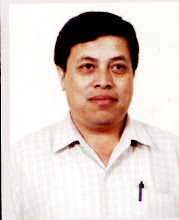Structure of DNA and its function
Chromosomes are made up of nucleoprotein. The nucleoprotein contains basic protein and nucleic acid. There are two types of nucleic acids. One is Deoxyribose nucleic acid (DNA) and other is Ribose nucleic acid (RNA). The nucleic acids were first reported by Friedrich Miescher (1871) from nuclei of pus cells. He called them nuclein . They are found in nucleus and cytoplasm. In cytoplasm, they have been found to be associated with protein synthesis.
Feulgen in 1924 developed fuchsin staining technique. With this technique, DNA was noticed in chromosome. DNA is storehouse of genetic material. It transmits information to RNA. DNA is a macromolecule formed by end to end polymerization of a large number of repeated units called deoxyronucleotide or simply nucleotide. Each nucleotide is made up of deoxyribose sugar, nitrogen base and phosphoric acid.
1. Deoxyribose sugar
It is a pentose sugar with five carbon atoms.
2. Nitrogen bases
They are of two types. A) Purines B) Pyrimedines
Purines are Adenine(A) and Guanine(G) with double ringed structure or dicyclic in nature. Pyrimedines are Cytosine(C), Thymine (T) and Uracil (U). In RNA, instead of Thymine, Uracil is present. Pyrimedines are single ringed or monocyclic in nature.
Nucleosides are formed by Purine or Pyrimedine nitrogen base and pentose sugar. DNA nucleosides are deoxyribose nucleosides.
3. Phosphate group
It is present as phosphoric acid H3PO4. Each phosphate group is joined to carbon atom 3 of one deoxyribose sugar and carbon 5 of another deoxyribose sugar.
James Watson and Francis Crick established a double helix or double stranded structure of DNA molecule in 1953 on the basis of X-ray diffraction method. They were awarded Nobel Prize in 1962. DNA is composed of 2 anti parallel poly nucleotide that form double helix around axis.
Each strand of DNA is made up of alternate bond of deoxyribose sugar and phosphate group joined by phosphodiester linkages. Each deoxyribose sugar in the strand has one nitrogenous base horizontally attached to it at carbon 1. The four nitrogen bases can occur in any possible sequence along the length of strand. The nitrogen base, deoxyribose sugar + phosphate group together form one unit of deoxyribose nucleotide. Many deoxyribonucleotide are linked with each other in a linear fashion. Therefore resulting strand is described as polynucleotide strand and DNA molecule as polynucleotide molecule.
Two polynucleotides are held together by Hydrogen bonds between specific pairs of Purine and Pyrimedine. Purine of one polynucleotide strand pairs with Pyrimedine of another strand.
A with T and C with G
A=T
C≡ G
Two strands of helix are of opposite polarity. One strand runs in 3→ 5 direction and another runs in 5→3 direction. The distance between two turns of helix is 34 Ȧ. There are 10 base pairs in a single turn with distance of 3.4 Ȧ between 2 base pairs. Single turn means distance between two shallow groups.
Functions
1. As genetic material – it carries hereditary information from one generation to another generation.
2. It has unique property of formation of exact copies which is essential for transfer of genetic information.
3. DNA forms RNA through Transcription process.
4. DNA plays role in protein synthesis.
5. Any change in sequence of nitrogen bases of DNA causes mutation.

No comments:
Post a Comment